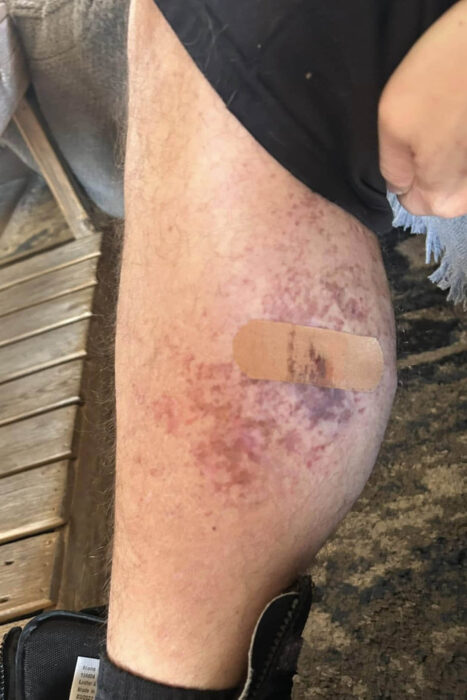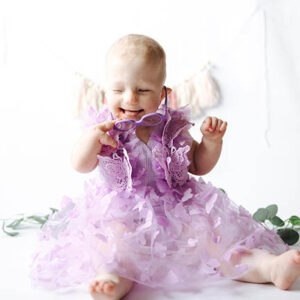Welcoming a new baby should be a joyful time. But, it can also feel overwhelming when your child is diagnosed with a rare and complex condition like Goltz syndrome. You don’t have to face this journey alone.
The NFED has created a practical guide to help you navigate your baby’s first year with confidence and support, “A Guide to the First Year of Life: Goltz Syndrome / Focal Dermal Hypoplasia.”
Download Goltz GuideWe are grateful to Rylee (Moody) Cook, M.D., Elaine C. Siegfried, M.D., and Laura Blieden, M.D. for writing this vital resource for parents of children affected by Goltz syndrome, which is also called focal dermal hypoplasia.
What is Goltz Syndrome?
Goltz syndrome is one of the more rare types of ectodermal dysplasia. A prevalence study we conducted found that for every 100,000 people, only .10 will be affected by the condition. It is a complex genetic disorder caused by a change in the gene called PORCN and it affects numerous parts of the body. Goltz syndrome is inherited as an X-linked dominant disorder. Because of this, most affected individuals are girls. However, some males can also have the condition.
Goltz syndrome can affect many different body parts. In the guide, you will learn about typical symptoms babies affected by Goltz syndrome will experience and how to best treat them. Learn about the various skin, hair, nail, bone, muscle, eye, oral, kidney and reproductive abnormalities as well as feeding difficulties and child development considerations.
Developing a Support Network
The guide is comprehensive and will be a great reference for you. Listening to other parents’ first-hand experience is also helpful. We reached out to several parents and asked them to share a little bit about what the first year was like for their child living with Goltz syndrome. In this blog, we’re featuring Rayven’s story. You will read more family stories in upcoming blogs.
Rayven’s Story: Thriving Through Challenges
By Alayna, mother to Rayven in Oklahoma

Rayven is doing well and is 14 months old now. She is blind and has microphthalmia and bilateral retinal colobomas. She sees an ocularist for her prosthetic lens in her right eye. Her left eye does have some light perception, which is already more than her doctors expected – who knows what the future looks like for her.

Her skin lesions were severe when she was first born. They have mostly improved now, although she still has areas of very thin skin on her lips and ear cartilage. She also has brittle nails. We have learned she is very sensitive to higher temperatures.
She has ectrodactyly of her right hand, but uses it surprisingly well, and is expected to have surgery on it when she is one year old to help improve the functionality of those two digits.
She was born with a patent foramen ovale (PFO) and patent ductus arteriosus (PDA) as well as a bicuspid aortic valve. Her PDA has closed and her PFO is almost closed, but she will always have the bicuspid aortic valve which could create some problems in the future. She will always have a cardiologist and get regular echocardiograms. I am not sure if it is common with Goltz syndrome to have a bicuspid valve or just coincidence.
She has an extra renal pelvis, which is not expected to create issues for her. Most of her affected areas of her body are on the right (right eye is more severe, right hand, right kidney, the skin on her right is more affected).
Rayven Has a Team of Doctors and Therapists
She has microcephaly (small head size) and her soft spots have started to close early so she sees neurosurgery and may possibly have skull surgery if this becomes an issue. She had a CT when she was born and is getting an MRI in a few months.
The biggest problem Rayven has faced so far is her slow weight gain. She was born at six pounds, eight ounces which was normal. But, since then she has been a very slow grower. She has always been in the first percentile of most charts (weight, head size). She passed her swallow study thankfully.

She sees a gastroenterologist (GI) doctor and they have been on top of us about a possible feeding tube. We keep telling her doctor it is very normal for Goltz syndrome children to be small statured and slow to gain weight. We have had to monitor every single ounce she eats, double fortify her formula, use special needs feeder bottles, etc. It is a constant battle.
She’s Small, But Not Failing to Thrive
I think sometimes the doctors look at her as a diagnosis and they automatically assume that her being small means “failure to thrive,” which is absolutely not the case at all. She loves to eat and is doing so well. She is just small. That is normal for her and her syndrome.
She sees an ear, nose and throat doctor and has small ear canals. But, her hearing is good. They will be doing an airway scope in a few months to check for airway papillomas. She had a little bit of lung atelectasis when she was born so she saw a pulmonologist, but that has resolved.
She sees a vision therapist who works on how we best accommodate her environment to be safe and interactive for her. Rayven started physical, occupational, and speech therapy at eight months old.
Our Family History of Goltz Syndrome
It is a long and complicated story, but we did actually know that Goltz syndrome existed, prior to Rayven being born. We just didn’t know that Rayven was affected by Goltz syndrome. My husband, Dalton, is 30 now, but when he was around six years old, he had a skin biopsy done. The results said similar to possible Goltz syndrome versus inconclusive.
At the time, there was not a lot known about this syndrome and so he never got a confirmed diagnosis. He did have slow growth and weight gain as a child, but didn’t really have any other symptoms (other than the skin), therefore further testing was never pursued.

When we went to our first OB/GYN appointment when we found out we were pregnant, we did tell the doctor that it was a possibility that Dalton had Goltz syndrome. Since all my prenatal tests/anatomy scans/DNA tests were all normal, we stopped worrying about that being a possibility. In hindsight, I wished we pushed harder for more testing. I didn’t know that the tests done during my pregnancy were not specific enough to test for Goltz syndrome.
My Husband Knew Our Newborn Was Affected by Goltz Syndrome
We wouldn’t change a single thing about our daughter because she is absolutely perfect and the light of our lives. However, it would have been nice to know about her diagnosis in advance so that the first couple of months after her birth wouldn’t have been such a complete shock and we could have worked on being more prepared.
The good thing is, as soon as she was born, my husband immediately knew she had Goltz syndrome (based on her skin lesions), so Rayven was able to get an early diagnosis and adequate treatments at a young age. Many Goltz children fight for a diagnosis for years.
Since then, Rayven and my husband’s genetic swabs were both positive for Goltz syndrome. My husband is a mosaic, meaning some, but not all, of his X chromosome is affected. Other than his skin lesions, you wouldn’t know anything was any different about him. My husband is a doctor of chiropractic, so his diagnosis has not slowed him down one bit. I am thankful that Rayven will have the best dad who knows what her syndrome is like to be able to learn from. It is interesting in our household, two-thirds of us are affected by such an incredibly rare genetic condition and I am the one who is outnumbered! Ha.
Our Baby Girl is Thriving

We have shared her story on Tik Tok (@rayvensmom) and Facebook (“Rayven’s Tribe”) and have connected with so many families like ours, and that has been the best part of this whole journey. To know that we are not alone and that my daughter will grow up being able to connect and meet others similar to her is really important to us.
Additional Resources
If you would like more information and support, you can explore the following NFED resources. You can always turn to the NFED staff if you need a question answered or just want to talk. Give us a call at 618-566-2020.
You may also consider joining our private Facebook group dedicated to individuals affected by Goltz syndrome and their loved ones. You will find a caring community who supports one another. And of course, attending an NFED Family Conference in the summer provides a deeper dive into learning more about the condition and connecting with affected adults and parents of children with the condition.
This blog is the first in a three-part series. Read the second blog to meet more families affected by Goltz syndrome and their children’s first year of life.
Have a question or comment? Contact us.
